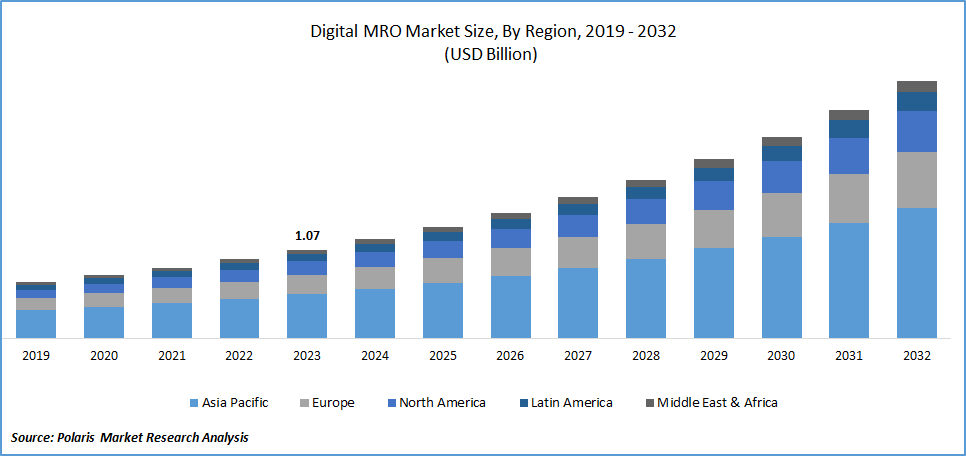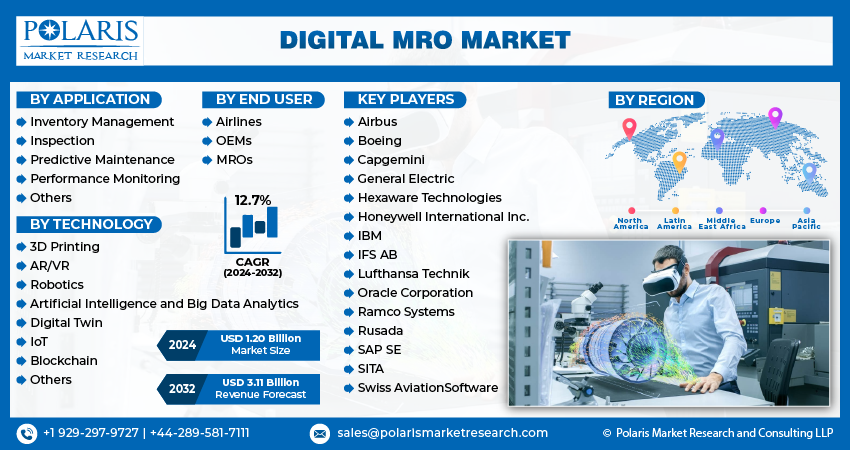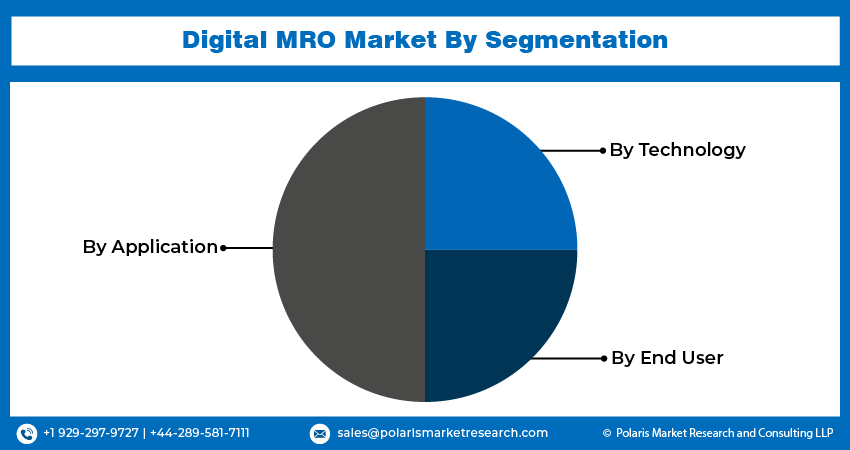
Digital MRO Market Share, Size, Trends, Industry Analysis Report, By Application (Inventory Management, Inspection, Predictive Maintenance, Performance Monitoring, Others); By Technology; By End User; By Region; Segment Forecast, 2024 - 2032
- Published Date:Feb-2024
- Pages: 117
- Format: PDF
- Report ID: PM4376
- Base Year: 2023
- Historical Data: 2019-2022
Report Outlook
The global digital MRO market was valued at USD 1.07 billion in 2023 and is expected to grow at a CAGR of 12.7% during the forecast period.
Digital MRO (Maintenance, Repair, and Overhaul) revolutionizes aviation maintenance through advanced technologies. It employs predictive maintenance using AI and IoT for real-time monitoring, enhancing condition monitoring. Digital MRO market optimizes processes, reduces costs, and extends aircraft lifespan, marking a data-driven transformation in aviation maintenance practices.
Its AI-driven insights optimize schedules, enhance safety, and extend aircraft life. Real-time data access through mobile apps improves decision-making, while cloud-based platforms streamline collaboration. The system ensures efficient workforce management, transparent supply chains with blockchain, and compliance with regulations. Immersive training using AR and VR technologies elevates technician skills. Beyond cost-effectiveness, digital MRO positions organizations to adapt to industry changes, reducing environmental impact and ensuring competitiveness in the dynamic aviation landscape.

To Understand More About this Research: Request a Free Sample Report
Companies are investing in R&D and market expansion to gain an edge. In addition, companies operating in the market are introducing new solutions to cater to the growing market demand.
For instance, in June 2023, Pratt & Whitney introduced Percept, an innovative AI-driven Aircraft Engine Analysis Tool. Percept uses computer vision technology, enabling users to acquire images and videos of aircraft engines through mobile devices. It offers real-time feedback on parts availability.
Post-COVID-19, the digital MRO market has witnessed accelerated adoption, emphasizing resilience and agility in response to pandemic challenges. Remote maintenance capabilities have gained prominence amid travel restrictions, reducing the need for physical presence. Cost optimization has become paramount, driving the focus on predictive maintenance and operational efficiency. The pandemic has underscored vulnerabilities in global supply chains, prompting a shift towards transparent and resilient supply chain solutions. The industry has adapted to new dynamics with flexible digital MRO tools, while collaborations and partnerships have fostered innovation. Safety measures have intensified, and digital solutions play a pivotal role in proactively addressing health and safety protocols in the evolving aviation landscape.
Industry Dynamics
Growth Drivers
Aging Aircraft Fleet and Technological Advancements
The increasing age of aircraft fleets has become a crucial driver, spurring the integration of digital Maintenance, Repair, and Overhaul solutions. As a growing number of aircraft exceed their initial design life, the aviation sector encounters distinct challenges in maintenance, reliability, and efficiency. In response, targeted digital MRO technologies have emerged to meet the specific requirements of aging aircraft. Adopting digital MRO within this context not only prolongs the operational lifespan of these aircraft but also addresses safety issues and ensures compliance with regulations. Faced with the unique challenges posed by aging fleets, the digital MRO market assumes an essential role, providing customized solutions to augment the reliability, safety, and cost-effectiveness of older aircraft.
Technological advancements are propelling the digital MRO market. Artificial intelligence utilizes predictive analytics to optimize maintenance schedules, while IoT devices enable real-time monitoring for continuous condition assessment. Big Data Analytics deciphers intricate patterns, aiding informed decision support in maintenance planning. Cloud computing fosters collaboration, augmented and virtual reality redefines technician training, and blockchain ensures transparent supply chain management. Digital twins facilitate in-depth understanding and proactive maintenance. Mobile applications empower technicians on the go, and robotics automate tasks with precision. The integration of 5G connectivity further enhances data transfer speeds, collectively reshaping the landscape of aircraft maintenance with sophistication and efficacy.

Report Segmentation
The market is primarily segmented based on application, technology, end user, and region.
|
By Application |
By Technology |
By End User |
By Region |
|
|
|
|
To Understand the Scope of this Report: Speak to Analyst
By Application Analysis
The Predictive Maintenance Segment Accounted for a Significant Share in 2023
The predictive maintenance segment accounted for a significant market revenue share of the market in 2023. Predictive maintenance employs advanced technologies to anticipate and address potential aircraft component issues before they lead to failures. Leveraging data analytics and machine learning, historical and real-time data are analyzed to predict maintenance requirements and identify patterns to foresee component failures. AI-driven early warning systems provide alerts for proactive maintenance measures. This approach optimizes maintenance schedules, minimizing downtime by tailoring activities to actual component conditions. The strategy focuses on reducing unscheduled downtime, enhancing fleet reliability, and realizing cost savings. Integration with digital twins allows for simulated analysis and predictive insights into component behavior. A continuous improvement loop refines predictive maintenance models, ensuring accuracy and effectiveness, marking a significant shift towards proactive and data-driven aircraft maintenance strategies.
By Technology Analysis
The Artificial Intelligence and Big Data Analytics Segment Accounted for the Largest Market Share in 2023
The artificial intelligence and big data analytics segment accounted for the largest market share and is willing to continue its dominance over the market forecast period. The integration of artificial intelligence and big data analytics has revolutionized digital MRO, optimizing aircraft maintenance across various dimensions. AI predicts equipment failures and optimizes schedules, while big data analytics identifies operational efficiencies. IoT sensors provide real-time data for continuous condition monitoring, and AI aids fault detection. Predictive analytics streamline inventory management, forecasting spare parts needs, and enhancing workforce efficiency. This synergy fosters a data-driven, proactive approach to maintenance, improving safety, cost-effectiveness, and operational excellence in the Digital MRO market landscape.
By End User Analysis
The Mros Segment Accounted for the Largest Market Share in 2023
The MRO segment accounted for the largest market share in 2023. MROs are revolutionizing operations with digital aircraft maintenance tools. Predictive maintenance systems, driven by data analytics and machine learning, forecast potential equipment failures, reducing downtime. IoT and sensors provide real-time monitoring for timely interventions and heightened maintenance precision. AR and VR enhance training and troubleshooting. Digital twins enable proactive maintenance planning, while mobile applications and cloud-based platforms streamline communication and data sharing. Electronic Flight Bags (EFBs) replace paperwork, improving efficiency and supply chain tools with blockchain to ensure inventory control and transparency. This collective integration of digital tools reflects a transformative shift toward data-driven, efficient, and proactive maintenance in the aviation industry.

Regional Analysis
Asia-Pacific is Expected to Experience Significant Growth During the Forecast Period
Asia Pacific is expected to experience significant growth during the market forecast period owing to rising air traffic and technological advancements. Strategic collaborations among companies, coupled with government initiatives to promote digitalization in aviation, have further shaped the market. The Asia-Pacific region has also witnessed an increased adoption of digital technologies like IoT and AI in MRO processes for improved efficiency. The proliferation of low-cost carriers also influenced MRO strategies, emphasizing cost-effective maintenance solutions.
North America's digital MRO market has witnessed notable technological advancements. There is a growing exploration of blockchain for transparent supply chain management, ensuring the authenticity of spare parts. Technologies such as augmented and virtual reality technologies are increasingly being adopted for immersive training and complex procedure visualization. The adoption of IoT and sensors for real-time monitoring, increased integration of AI and ML algorithms for predictive maintenance, and advanced data analytics to optimize MRO processes have also gained traction. Cloud-based solutions have gained traction for enhanced accessibility and collaboration.

Key Market Players & Competitive Insight
The market faces fierce rivalry, with companies leveraging cutting-edge technology, top-notch product offerings, and a robust brand reputation to propel revenue expansion. Key players employ diverse tactics, including dedicated research and development, strategic mergers and acquisitions, and continuous technological advancements. These strategic maneuvers are aimed at broadening their product ranges and sustaining a competitive advantage. The market dynamic is shaped by constant innovation and a commitment to delivering high-quality solutions, underscoring the importance of strategic initiatives in ensuring sustained competitiveness.
Some of the major players operating in the global market include:
- Airbus
- Boeing
- Capgemini
- General Electric
- Hexaware Technologies
- Honeywell International Inc.
- IBM
- IFS AB
- Lufthansa Technik
- Oracle Corporation
- Ramco Systems
- Rusada
- SAP SE
- SITA
- Swiss AviationSoftware
Recent Developments
- In October 2023, EmpowerMX unveiled EMX Vision, a module harnessing artificial intelligence (AI) to revolutionize MRO (Maintenance, Repair, and Overhaul) planning and execution. This advanced tool, built upon machine learning and predictive modeling, enables MRO organizations to utilize both internal and external data, delivering highly precise turnaround times to customers.
- In May 2023, Swiss Aviation Software (Swiss-AS) and Volocopter entered into a multi-year agreement for the utilization of AMOS, the maintenance, repair, and overhaul (MRO) software developed by Swiss-AS. AMOS is set to play a crucial role in overseeing Volocopter's global fleet of electric vertical takeoff and landing (eVTOL) aircraft.
Digital MRO Market Report Scope
|
Report Attributes |
Details |
|
Market size value in 2024 |
USD 1.20 billion |
|
Revenue forecast in 2032 |
USD 3.11 billion |
|
CAGR |
12.7% from 2024 - 2032 |
|
Base year |
2023 |
|
Historical data |
2019 - 2022 |
|
Forecast period |
2024 - 2032 |
|
Quantitative units |
Revenue in USD billion and CAGR from 2024 to 2032 |
|
Segments covered |
By Application, By Technology, By End User, By Region |
|
Regional scope |
North America, Europe, Asia Pacific, Latin America, Middle East & Africa |
|
Customization |
Report customization as per your requirements with respect to countries, region, and segmentation. |
FAQ's
The global digital MRO market size is expected to reach USD 3.11 billion by 2032
Airbus, Boeing, Capgemini, General Electric, IBM, Ramco Systems, and SAP SE are the top market players in the market.
Asia-Pacific region contribute notably towards the global Digital MRO Market.
The global digital MRO market is expected to grow at a CAGR of 12.7% during the forecast period.
The Digital MRO Market report covering key segments are application, technology, end user, and region.
